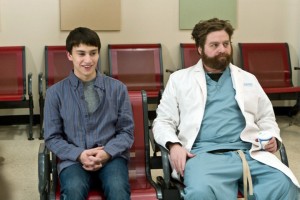 It’s Kind of a Funny Story, a movie based on It’s Kind of a Funny Story by former NYPress columnist Ned Vizzini, is a (mostly) realistic portrayal of a high-achieving teenager who also has a case of high anxiety and projectile “stress vomiting”. Craig Gilner, a 16 year old in a prestigious, competitive NYC high school with a stable, middle-class family, has a lot of “little” problems, but the pressures to succeed academically, join a prestigious summer program, and work towards going on to a good college and a good job are building up on him, and he is having suicidal thoughts, including a vivid dream of jumping off the Brooklyn Bridge.
It’s Kind of a Funny Story, a movie based on It’s Kind of a Funny Story by former NYPress columnist Ned Vizzini, is a (mostly) realistic portrayal of a high-achieving teenager who also has a case of high anxiety and projectile “stress vomiting”. Craig Gilner, a 16 year old in a prestigious, competitive NYC high school with a stable, middle-class family, has a lot of “little” problems, but the pressures to succeed academically, join a prestigious summer program, and work towards going on to a good college and a good job are building up on him, and he is having suicidal thoughts, including a vivid dream of jumping off the Brooklyn Bridge.
He initially calls a suicide hotline, but ends up just showing up at a fictional hospital, walking into the ER, and checking himself in on the grounds that he is suicidal. In the waiting room of the ER, he meets Bobby, a character he initially thinks is a doctor, but whom he later discovers to be a patient in the hospital’s psych ward when he ends up there.

Craig and Bobby meet in the Emergency Room
One of the deleted scenes included on the DVD version of the movie shows a call to a suicide hotline which is largely ineffective except for the volunteer’s recommendation that he should go to a hospital because “suicide is a medical illness”. As such, when he gets to the hospital, he fully expects to be given a pill or a shot, along with a few words of encouragement, and quickly released. Not so. He is told that he will be staying for at least 5 days.
To Craig’s surprise, the adolescent wing is “under renovation”, thus requiring the hospital to place adolescent patients in the adult psychiatric ward. In New York, it is perfectly legal to have adolescents 13 and over committed to mental hospitals and wards serving an adult population. It is also legal to send children age five and over to mental hospitals where adults are committed.
In fact, such a situation is more common than not in New York City. New York has a dearth of adolescent mental health services, and adolescent-only wards or institutions are small population and relative rarities.
Craig is given the tour of the ward and discovers that his new roommate is a middle-aged depressive named Mustafa who never gets out of bed. Unlike Mustapha, Craig still “functions” and does so well enough for there to have been no obvious problems (he didn’t lose his place as an honor student, although he displays some serious anxiety about this possibility) other than his previous prescription for Zoloft. Bearded Bobby soon becomes a mentor and a father figure.
Among the unrealistic elements in the movie, patients routinely don doctors’ white coats and scrubs and sneak out of the psych ward incognito in this fashion. In of these instances, Bobby bribes the janitor with a couple of pills to let him and Craig have the use of an unrealistically large gymnasium, where the pair shoot baskets, and Bobby gives Craig advice on asking out Noelle, another teen patient in the facility. It might be realistic that in such a situation of adolescents confined with adults, an adult patient may become a mentor to a teen, but it is just as realistic that adults might take advantage of teens in multitudinous ways not shown or discussed in the movie, but implied when it is pointed out that there is no lock on the shower room door.
One of the other realistic elements in the portrayal of the psych ward would be the practical problems disclosed by many of the patients in the adult psych ward. Rarely do they have any money beyond petty cash, and even that takes some time and ingenuity to pool to have enough for a patients’ pizza party. Those who are getting released have to figure out where to go and what to do next. This is indirectly portrayed by muted but anxiety ridden phone conversations on the part of other patients who say things like “I don’t have a job lined up yet”, and Bobby’s upcoming interview for admission to a group home, for which Craig lends him a button-down shirt belonging to his father, because Bobby does not have a dress shirt with him in the ward, or anyone on the outside willing or able to bring him one.
Also somewhat unrealistically, in his five days in the hospital, Craig manages to cure his eating disorder, successfully develop a relationship with Noelle, find a record with Egyptian music that gets Mustapha out of bed and joining the patients’ pizza party, realize he wants to take an art class, stand up to his father, and becomes determined to return to the hospital and volunteer there.


